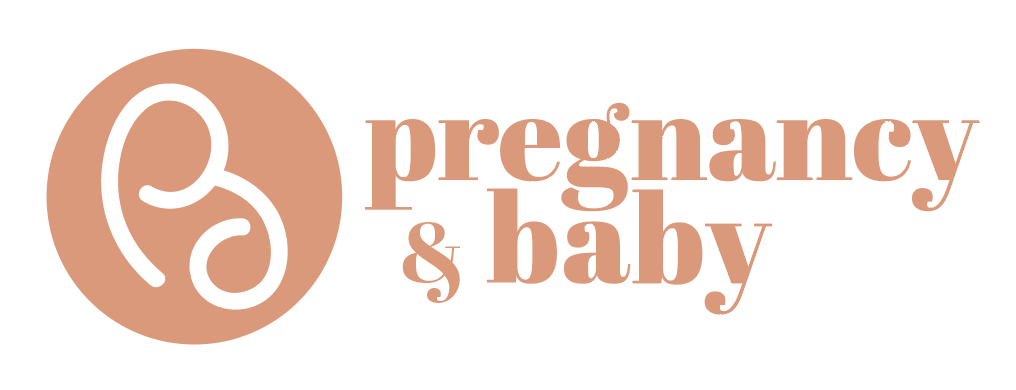
Newborns sleep from 12 to 18 hours per day, and several studies have shown that it is vital to maintain sufficient quality sleep for healthy cognitive development in babies. Quality sleep is also linked to babies’ overall health and mental development, as well as their moods. Poor sleep infancy has also been linked to obesity as a child, and later on as an adult.
Is your baby being cranky or fussier than usual? That is one of the first signs that your baby is sleep-deprived, which can be stressful for both parent and baby. Learn how to recognise some of the tell-tale signs that your baby is not getting quality sleep.

Ensuring that your baby gets sufficient quality sleep can greatly improve their mental health, mood and cognitive brain development in the long run. In this exclusive interview with Dr. Wong, we discover 7 tips to help your babies achieve quality sleep.
#1: Create A Sleep Schedule
When asked if their babies have a bedtime, most parents will give generic answers like ‘after dinner’, or ‘after I rock him to sleep’. One of the determining factors of having quality sleep is to develop a sleep schedule for your baby, meaning a fixed sleep and waking time.
Dr. Wong shares that babies sleep for 2 to 5 hours at a stretch, so observing the cues when their baby is sleepy can help parents develop a sleep schedule based on their child’s behaviour and sleeping patterns.
#2: Swaddle Your Baby
From birth to 4 months old, babies have a startle reflex that causes them to feel as if they are falling. This sensation causes jerking movements that wake them up.
To help your little ones achieve a good night’s sleep, swaddle them in light and breathable fabric to reduce the jerking movements and help them sleep better. Swaddling also mimics the womb environment, creating a sense of security.
According to Dr. Wong, this is a good technique to help over-stimulated newborns achieve less disruptive, quality sleep.
#3: Develop a Bedtime Routine
Since babies have not developed a natural circadian rhythm, a bedtime routine can help them to unwind and signals the body that its bedtime. This also triggers the release of melatonin that makes them feel sleepy.
Dr. Wong shares that the best routine is consistent and practised with love, and ranges from 20 to 45 minutes. An example of a bedtime routine could be dinner, followed by a change of diapers, putting on pyjamas, singing songs, and dimming the lights.
Never rush through a routine, as your baby will be able to sense your nervous energy. Be sure to repeat the bedtime routine in order every night and your baby will soon learn that its bedtime.
#4: Take A Bedtime Bath
A bedtime bath is great for helping your little ones fall asleep easier. However, this varies from baby to baby. Some babies may feel calmer and sleepy after a bath, while other babies may become more active.
Parents may wish to include a bath into your bedtime routine, and see how your baby reacts to it before deciding if it’s a permanent addition to your baby’s bedtime routine.
Dr. Wong adds that bathing is a form of touch therapy that is great for strengthening bonding and security between parent and child while developing a baby’s sensory skills through their sense of smell and touch.
#5: Babies Sleep Better in Dim Environments
Babies tend to fall asleep in brightly-lit environments, like the living room, where parents can keep an eye on them during their downtime. Since they sleep on their backs facing upwards, the harsh glare of the ceiling light is often in their line of sight.
Studies have shown that this glare may be disruptive to babies’ sleep, and a dim environment under 20 lx (International Units of Illumination) creates the ideal sleeping environment for your little ones.
Contrary to what many may think, complete darkness is not the best sleeping environment, as it makes your babies feel uneasy, resulting in disrupted sleep. Consider a crib or rocking chair with a hood to block out the harsh glare from the television or lighting for better sleep.
#6: Don’t Place Baby in Crib Immediately After They Fall Asleep
Once your baby falls asleep in your arms, avoid putting them in the crib immediately as they are still in the light sleep stage. Babies will enter deep sleep stage in 20-25 minutes after falling asleep, and this is a safe time to transfer them into the crib.
Dr. Wong adds that parents can also observe their babies eyelid movements. If there are still movements, they are likely to wake if they notice a change in the environment from their parents’ arms to the crib.
#7: Hang It There Until The 4-Month Milestone
Before your baby is 4 months old, they instinctively tend to wake more frequently during the night as environmental triggers can easily rouse them. From the temperature to hunger pangs or even when they are feeling unwell. Your baby’s circadian rhythm starts to develop around the 4-month mark, and they will tend to sleep for longer stretches during the night.
Don’t ignore your baby when they’re crying as they are signalling or trying to tell you something. Ignoring them will not help them fall asleep faster. Dr. Wong suggests to play with them more during the day to burn off energy, and avoid active games or over-stimulating your baby near bedtime.
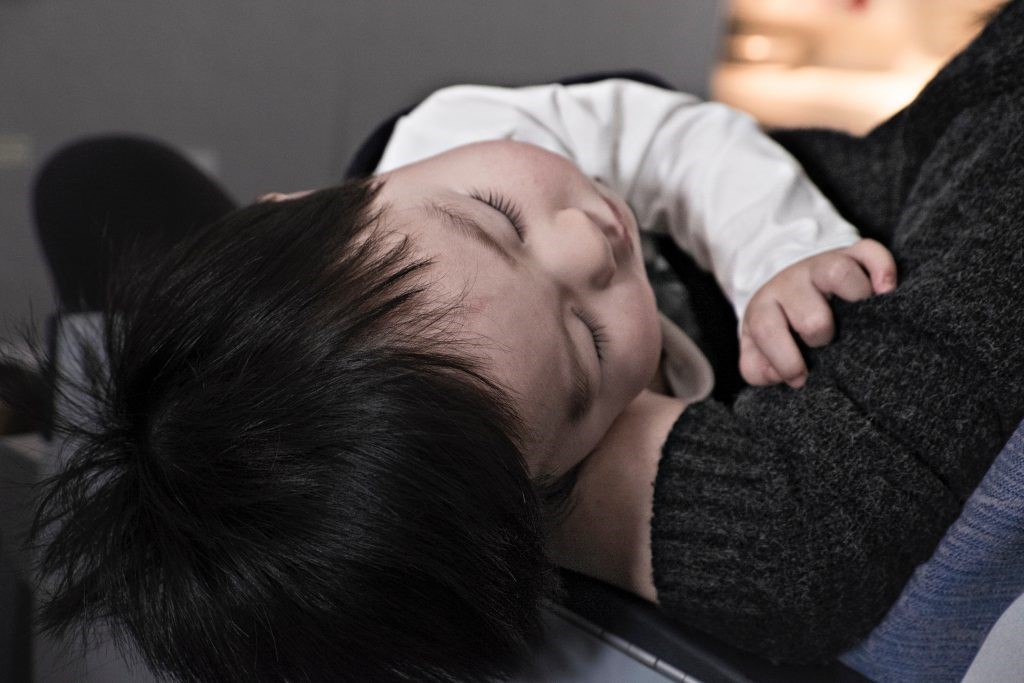
Create The Best Sleeping Environment For Your Little Ones
The American Academy of Paediatrics (AAP) recommends room-sharing for newborns, in which a baby’s crib or bassinet is placed in the parents’ room to allow ease of feeding, comforting and monitoring at night. Parents can consider investing in a multi-functional electric rocking chair, which can improve your baby’s sleep quality and help their brains develop optimally.
A dark sleeping environment is ideal for your baby to get quality sleep, and melatonin (sleep hormones) are released in the dark. Combi’s BEDi parenting station can help create a dark environment by shading your baby with a sleep shell. Its innovative dome structure is designed provides a sense of safety, while effectively blocking up to 99.9% of indoor or outdoor light. The sleep shell also shields your baby’s eyes from harmful blue light from the television or lighting, which may hinder the release of melatonin in the body.

Combi’s BEDi parenting station also has a double-sided Dacco Plus newborn cushion to provide support for the baby’s head, back and arms by dispersing the pressure for maximum comfort. Invest in this smart splurge, which comes highly recommended for fussy sleepers, giving parents more downtime for self-care and peace of mind.
Combi’s BEDi Parenting Station retails at $599.

The Importance of Sleep for Your Baby
Want to know the secret to boost your baby’s IQ? The answer is simple – sleep. Many studies have shown that adequate sleep during infancy is crucial for optimal intelligence. Getting sufficient quality sleep is the key factor for the maturation of the brain and central nervous system, and the most crucial development occurs in the first two years of life.
The recommended sleep time for infants should ideally be 14-18 hours per day and quality sleep is linked to a range of benefits, like higher IQ and EQ, heightened memory and improved cognitive ability.
What Happens To Your Baby’s Brain During Sleep
During pregnancy, the foetus rapidly develops from an embryo to form the baby’s brain, spinal cord and organs. This process occurs while the foetus is in a long-term sleep state in the womb. After delivery, the weight of the baby’s brain actually doubles from 400 grams to 800 grams within a year. At the age of 2, the brain weighs about 1000 grams, which is a third the weight of an adult brain.
Experts estimate that Human Growth Hormones (HGH) released by the body during sleep is three times more than during waking, hence the growing emphasis on adequate sleep during infancy. This hormone is especially active in infants and growing children, acting as an essential building block for the brain’s growth and development.

Learn to Recognise Your Baby’s Sleep State
There are two types of sleep states:
There are 4 stages during NREM.
Stage 1: Drowsiness, you will observe your baby dozing off
Stage 2: Light sleep (any movement or sound may startle your baby)
Stage 3: Deep sleep (baby’s breathing and heartbeat are stable)
Stage 4: Very Deep Sleep (baby is not easily awakened by surrounding factors)
A baby sleep cycle alternates between the various stages throughout the night. A baby enters stage 1, then moves into stage 2, then 3, then 4, then back to 3, then 2, before cycling back to REM. Babies are most sensitive to movement and noise as they may move between light and deep sleep, and may experience difficulty going back to sleep once they are awake.

Ask The Doctor: Exactly How Important Is Sleep For My Baby?
The most fundamental factor affecting an infant’s growth and cognitive development is sleep, explains Dr Wong, an expert in infant cognitive development. We find out all about infant sleep and cognitive development in this exclusive interview.
Q: At what age is sleep the most critical for healthy brain development?
Dr. Wong: Sleep is especially critical for cognitive development within the first 2 years of life. A baby’s brain will start developing as early as 3 weeks after conception, and most of the primary activity during brain development happens during sleep. While sleep time varies from birth to adolescence, it is still crucial for every age group.
One study even found that sleeping less than 10 hours per night from birth to age three resulted in a greater tendency for language and reading problems in children, and these issues persisted later in life.
Are daytime naps the same as night sleeps in boosting my child’s IQ?
Dr Wong: It is never one or the other, both are just as important. In fact, babies’ sleeping routine at night can be disrupted if they don't get enough sleep during the day, causing night awakenings that may adversely affect brain development.
Children require daytime naps until at least around the age of two and a half to three years, even if the child may sleep well at night. Many studies also point to the positive correlation between the duration of daytime naps and memory, suggesting that more naps can actually improve a child’s ability to retain information.
What is the biggest factor that affects my baby’s sleep?
Dr. Wong: Irregular bedtime could be the biggest factor when it comes to quality sleep for your child. The lack of a bedtime routine disrupts the circadian rhythm (body clock), leading to sleep deprivation that affects the developing brain.
The second factor is the sleeping environment. Babies find dark rooms extremely comforting, making it easier for them to fall asleep and remain in a state of deep sleep for longer periods of time. A dark sleeping environment also promotes the release of melatonin, a sleep hormone that tells your baby’s body that it’s time to sleep. Melatonin is crucial to help your baby regulate their circadian rhythm to develop a healthy bedtime routine.
Parents may also consider the following factors for a good night’s rest for your baby:
Q: What is the ideal number of hours my baby should be sleeping?
Dr. Wong: Babies need at least 14 to 18 hours of sleep, depending on their age, and most babies do not begin sleeping through the night (six to eight hours) without waking until about 3 months of age.
Newborns sleep about eight to nine hours in the daytime and about eight hours at night. However, they may not sleep more than one to two hours at a stretch, hence the importance of a bedtime routine.
Q: Why doesn’t my baby sleep through the night?
Dr. Wong: Babies are not innately born with the sleep-wake cycle, which is a routine that develops as they grow older. They tend to be very light sleepers, and a large proportion of their sleep is active sleep. This is also why babies take 6 months to 1 year of age to be able to sleep through the night.
Q: Any useful tips on helping my baby get a good night’s sleep?
Dr. Wong: Every baby is different, and there are many factors that may affect the sleep quality of your child. For example, if the newborn baby has a heavier head, it is necessary to pay attention to whether the headrest can provide sufficient support to protect the head and the cervical spine.
Should you notice any slight movement or sounds from your baby, it can be helpful to pick your baby up and try to rock them back to sleep. This increases the likelihood of your baby re-entering deep sleep within the next few minutes. If you observe that your baby is wide awake, check their diaper or any other external factors that may be causing discomfort to your child.
Helping Your Little Ones Get a Good Night’s Sleep
A large amount of evidence has shown that getting adequate sleep can directly impact future cognition, temperament and psychomotor development in infants. For optimal development of your baby’s cognitive abilities, parents must ensure sufficient sleep time and encourage healthy sleeping habits.
When it comes to finding an ideal sleep environment, parents should avoid deliberately creating a quiet environment for the baby, as this will only increase your baby’s sensitivity to sounds, and they develop a tendency to be easily awakened by subtle sounds in the environment. An easy solution to your baby’s sleep woes is to invest in a multi-functional electric rocking chair, which can improve your baby’s sleep quality and help their brains develop optimally.
Combi’s Fealetto Auto Swing is equipped with an auto-rocking function and 7 soothing lullabies to gently ease your little ones into bedtime. It comes with a Dacco Plus's sleep cushion, exclusively designed for newborn babies for ultimate comfort. In a Japanese experiment, more than 94% of the babies fell asleep within 15 minutes of swinging in Combi’s Fealetto Auto Swing.
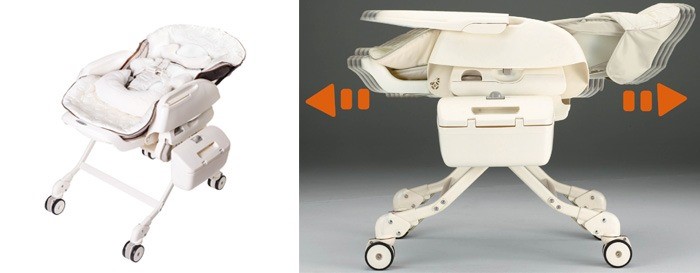
A dark sleeping environment is ideal for your baby to get quality sleep, and melatonin (sleep hormones) are released in the dark. Combi’s BEDi parenting station can help create a dark environment by shading your baby with a sleep shell. Its innovative dome structure is designed provides a sense of safety, while effectively blocking up to 99.9% of indoor or outdoor light. The cuddling-style seat cradles your baby in Combi’s BEDi parenting station to create a comfortably dim environment that shields your baby’s eyes from any harsh light. Invest in this smart splurge, which comes highly recommended for fussy sleepers, giving parents more downtime for self-care and a peace of mind.

Combi Fealetto Auto Swing retails at $799.
Combi’s BEDi Parenting Station retails at $599.
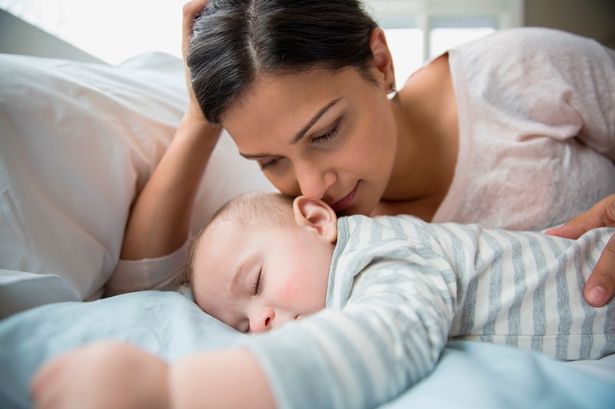
One Bed Fits All
Sleeping in the same bed as your baby remains a controversial topic in the parenting world. Both experts and parents alike have widely conflicting views on whether parents should co-sleep with their baby due to the safety risks involved.
Whether you choose to co-sleep with your baby or not is ultimately up to you as the parent. Let’s take a look at some of the reasons on both sides of the debate.
Pros
Nothing beats the joy of snuggling next to your little one in bed while both of you drift off to sleep, and waking up the next morning to a smiling baby. This gives a special bonding experience between mother and baby and.
One popular reason for co-sleeping is the convenience it brings to breastfeeding. As the baby will lying on the bed right next to the mother, there is no hassle of getting out of bed to nurse the baby back to sleep. Thus, there is less disruption for both mother and baby, which allows the baby to fall back asleep easily, and the mother will get a better night’s rest too. The ability to continue breastfeeding for a longer period of time will consequently give added benefits to the baby.
Cons
Concerns relating to safety are key factors as to why co-sleeping with baby is discouraged. “Sharing a bed is not recommended for safety reasons, as there is the risk of the baby being rolled over by a sleeping adult or an older child, resulting in suffocation of the baby. Studies have also shown that there is a higher incidence of Sudden Infant Death Syndrome (SIDS) in households where families practise bed sharing,” says Dr Wendy Liew Kein Meng, Paediatrician, SBCC Baby & Child Clinic.
Apart from safety concerns, co-sleeping might also result in the baby relying on the breast to fall asleep – a condition known as sleep onset association disorder – due to the mother breastfeeding the baby to sleep in bed. This can make it difficult for the baby to stay asleep as it grows older, which will also increase the interruptions to the mother’s sleep since she has to wake up frequently at night during bed time.
If you wish for your baby to be in close proximity with you while sleeping, let your baby sleep in your room, but on a separate area such as a crib placed next to your bed. The American Academy of Paediatrics recommends infants sleep in their parents’ room for the first six months up to, ideally, the first year of life. Room-sharing is a great alternative to bed-sharing with your baby as it lowers the risk of SIDS.
Practise Safe Co-Sleeping
If you choose to have your baby share your bed, be sure to take the following safety precautions to ensure there are no dangers posed to your baby.
1. Baby’s sleeping position
Place you baby to sleep on his/her back so there is no obstruction to baby's breathing while he/she is sleeping. Sleeping on the front can increase the risk of SIDS as your baby will have more difficulty breathing.
2. Parents’ sleeping position
A parent’s sleeping position matters as much as the baby’s sleeping position. When you are sleeping next to your baby, lie on your side while facing your baby, and curl your body in a C-shape around him, making sure your knees are placed under his feet. This sleeping position can stop you from rolling forwards or backwards while you are sleeping, minimising the risk of crushing your baby.
3. Your bed mattress
Ensure your bed mattress is firm so your baby is well-supported while your baby is sleeping. Avoid using waterbeds, soft mattresses, or any other heavy beddings such as quilts or blankets that may potentially cause suffocation.
4. No spaces around bed
Make sure your bed has no spaces or crevices where your baby can be entrapped in. Your bed’s mattress should be tightly-fitted to the headboard and footboard, and there should be no space between your bed and the adjoining wall where your baby might fall into.
5. No unnecessary objects on and around the bed
Remove any unnecessary items prior to bedtime. There should be no objects anywhere near your baby’s face while he/she is sleeping. “Objects such as pillows, blankets or stuffed animals that could potentially land near the baby’s face should be avoided. Sleep clothing such as sleep sacks or wearable blankets are good alternatives to blankets,” says Dr Liew.
6. Co-sleep in the bed only
Confine your co-sleeping with the baby on your bed only. Sleeping with your baby on other places such as a couch, armchair or recliner is highly discouraged because this greatly increases the risk of SIDS.
7. Height of your bed
Be sure to take into account the height of your bed if your baby is sleeping in it with you. The possibility of your baby getting injured if he/she falls off the bed increases if your bed is further away from the floor.
8. Hair hazards
Tie your hair up while sleeping with your baby to prevent your hair from accidentally wrapping around his/her neck, causing suffocation.
9. No more than one child allowed on the same bed
If you have other children, do not let them sleep in the same bed too as they might be unaware of the safety precautions to take while sleeping with the baby.
10. What parents should avoid
If you wish to co-sleep with your baby, it is important that both you and your partner have not been drinking alcohol since the effect of alcohol on your body might make you less aware of your baby’s presence in your bed. Medications that can cause drowsiness should also be avoided.
Parents who are smokers should also not co-sleep with their baby. Smoking increases the risk of SIDS wherever your baby sleeps as your baby is being exposed to the cigarette smoke.

Dr Wendy Liew Kein Meng
Paediatrician
SBCC Baby & Child Clinic
MBChB (Glasgow), MRCPCH (Paeds)(UK), FAMS
Special Interest in Paediatric Neurology
This article is brought to you by Healthway Medical.

Eczema (aka atopic dermatitis) is a chronic inflammatory skin condition that makes skin extremely dry, red and itchy. More severe cases of eczema can even cause skin to look cracked and leathery, and for mums and bubs, that’s a big no-no!
Eczema affects people of all ages but most commonly in young children below 5 years of age. Babies may outgrow it before they hit adulthood, but unfortunately, the condition is often chronic for many adults who suffer from it. There’s also no known cure for eczema too; all we can do is keep the condition (and subsequent itchiness!) at bay with medication and moisturising creams.
Does my baby have eczema?
Common symptoms usually appear on baby when they’re under 5 years old, and their usual areas of appearance are typically on the face, neck and extensor skin surfaces but it could spread to other parts of their body.
The flare might look like dry, thick, scaly skin, or could look like clusters of red bumps. If the flare gets infected due to scratching or friction caused by baby moving or rolling around, it can leave their skin scarred!
✏️ When in doubt, always visit your doctor and let them examine baby’s skin – they may even refer you to a dermatologist for confirmation and treatment.
What causes eczema?
Eczema indicates a defect in skin barrier. The skin barrier is the outermost layer of epidermis or the outermost layer of your skin. A healthy skin barrier has sufficient amount of Ceramide to help keep allergens and bacteria out, and prevents water evaporating from your skin. But when skin barrier is impaired, it is characterised by a lack of Ceramides and other physiological lipids. Therefore, allergens and irritants such as toxins, chemicals and pollution can penetrate through the skin's layers a lot more easily. Ceramide is an important lipid forming the skin barrier.
Continue reading on the next page...
How can I treat baby’s eczema?
Taking good care of baby’s skin and avoiding potential triggers can help treat and prevent eczema from flaring up. Visiting a dermatologist will help you determine a treatment plan for baby if they have eczema.
💡 You can also consider using Ceradan products for baby from 0 months onwards – they’re all hypoallergenic and suitable for baby’s sensitive skin.
Regular use of moisturisers prolongs the flare-free period and reduces the need for steroid cream. Using the right wash also matters in keeping eczema under control. Ceradan products are scientifically designed with an optimal 3:1:1 ratio of Ceramide, Cholesterol and Free Fatty Acids in maintaining the lowest trans-epidermal water loss, providing accelerated skin barrier repair for patients with eczema.

Ceradan Skin Barrier Repair Cream is a ceramide-dominant therapeutic moisturiser that replenishes the depleted ceramide in the defective skin barrier. It should be applied liberally at least twice a day to affected eczema flares.
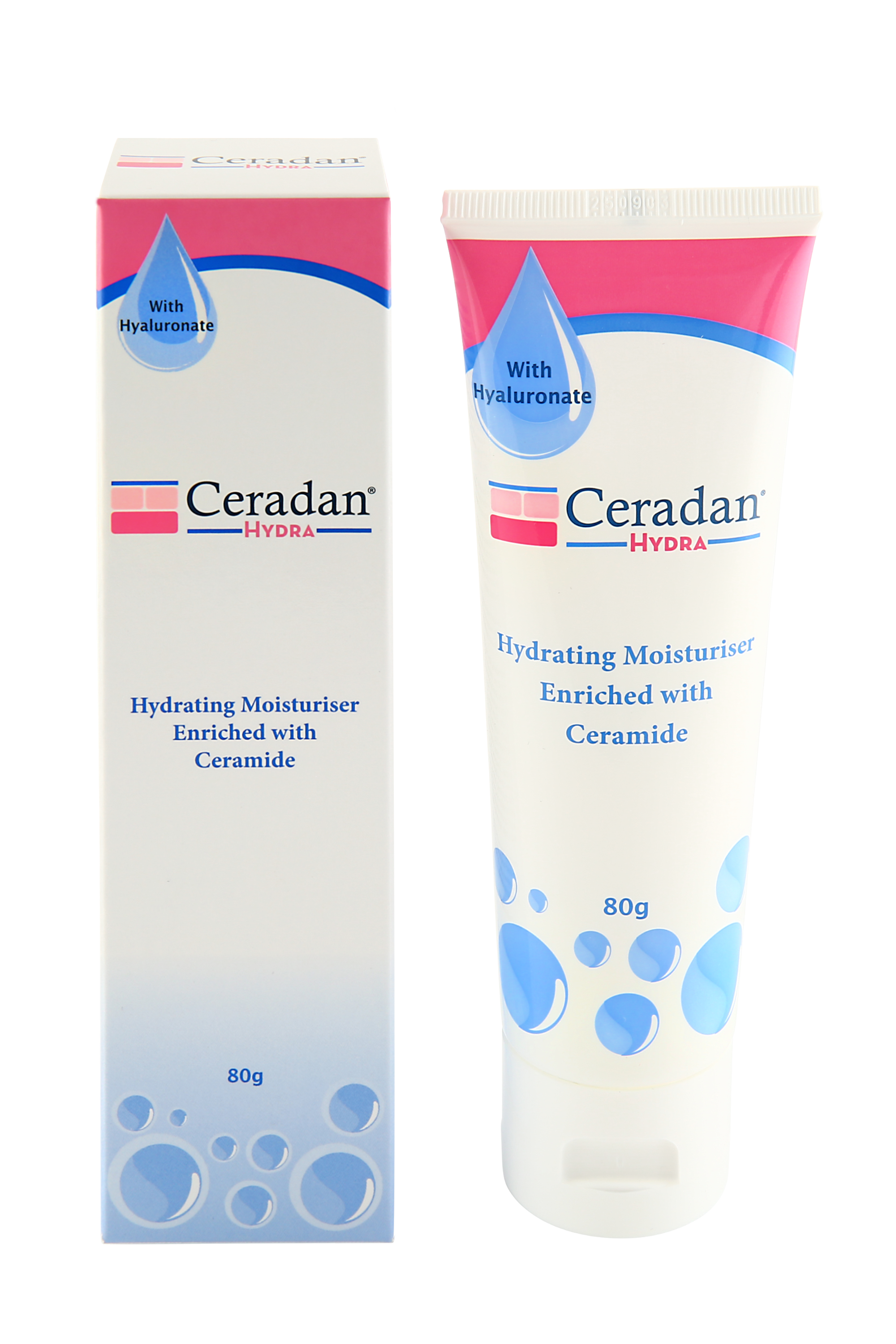
As a complement for the Ceradan Skin Barrier Repair Cream, the Ceradan Hydra works perfectly – for the best effect, use it in-between applications of Ceradan Cream. It’s a hydrating moisturiser that’s also enriched with ceramide, and is a step-down maintenance therapy during periods of non-flares. It also contains sodium hyaluronate that helps to draw moisture into the skin. Easy to apply, it spreads smoothly over skin areas with or without flares. It can also be applied frequently to keep the skin barrier strong, even when skin appears normal.

If you’re looking to wash baby’s gentle skin, Ceradan Wash is what you need. It’s a gentle, non-soap body wash that cleanses the skin and protects the skin barrier at the same time. It ensures that skin does not feel tight or dry after a wash. Bathe Baby with Ceradan Wash at least once a day to prevent allergen and pathogen build-up on the skin.
Ceradan can be found at major hospitals' retail pharmacies.
Pregnancy and Baby Singapore provides you with the latest news and practical tips to help you in your parenting journey. For more tips on your pregnancy and baby in Singapore, subscribe to our mailing list and like us on Facebook, to receive new articles for mummies like you every week!
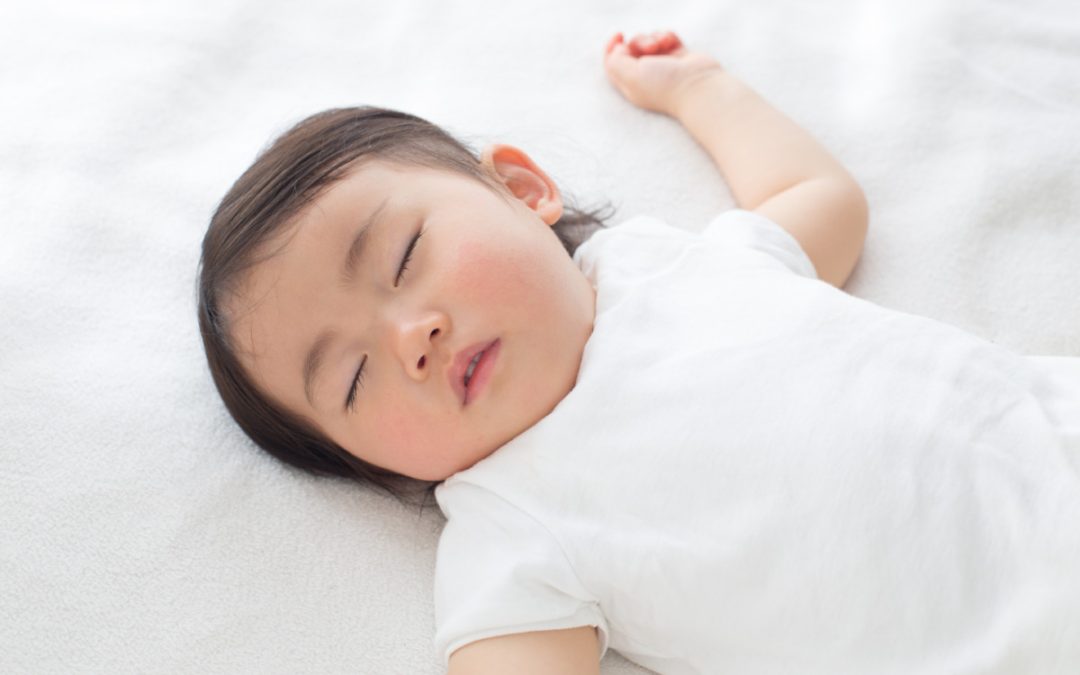
When it comes to sleep, few families are lucky enough to have a child with no sleep issues. But so you know just how important sleep is for your child’s brain development? Let us share some pointers to get your baby to adopt good sleeping habits!
Being awakened several times a night by a wailing baby is common for every parent. While that is something most parents eventually get used to, the fact that sleep is extremely important for babies. It is as vital to their growth as good nutrition!
What is healthy sleep?
Here are some pointers for helping baby to sleep soundly
Watch for signs of tiredness
If you wait too long to put baby to sleep, they may be overtired and have trouble sleeping. The myth is that children will sleep when they are tired. Often, children become ever more active when they are tired! They get whiny, fussy and uncooperative. This disturbs their concentration and moods.
Teach them the difference between day and night
Interact with baby during the day. keep the house and room bright. Don’t try to reduce the volume of noise around the house. In the day, have outdoor activities where the child is exposed to natural sunlight.
Start a bedtime routine
Observe baby for signs of sleepiness. Keep to a routine and fixed time to sleep, even during weekends. Make an exception only for special occasions. Have a simple sleep ritual – wash-up, brush teeth, bedtime story and lights off.
Avoid watching TV, playing games or mobile devices in the bedroom or on the bed.
Separate eating from sleeping
Don’t prop a bottle in your baby’s mouth when you put him to bed. It can lead to choking or ear infections!
Pregnancy and Baby Singapore provides you with the latest news and practical tips to help you in your parenting journey. For more tips on your pregnancy and baby in Singapore, subscribe to our mailing list and like us on Facebook, to receive new articles for mummies like you every week!

When it comes to a baby’s fever, the best thing you can do is to be prepared and don’t freak out! Here’s everything you need to know about what to do when baby gets a fever, how to treat it and when to visit the doctor.
1. Baby has a 38-degree fever but is still active. Should I bring her to the doctor?
Fever in itself is not an illness. It’s usually a symptom of an underlying problem and is the body’s way of fighting the germs that cause infections. Fortunately, most fevers in children are due to minor infections and resolve themselves in a few days. In fact, mild to moderate fever is known to shorten the duration of a number of common illnesses. Most fevers with viral illnesses range from 38.3 deg C to 40 deg C, and last 3 to 4 days. They may be associated with other symptoms like cough, runny nose or diarrhoea. In general, the fever at its height doesn’t correlate with the seriousness of the illness. What counts is how sick is your child.
2. When is the fever a sign of something serious?
If your child remains well and active, you may choose to monitor her for 2 to 3 days. If her fever rises above 39 deg C or if she seems to be getting sicker and has any one of the following symptoms, go to the clinic immediately:
3. She always spits out/struggles to take her medicine. What can I do?
Most doctors will give you a syringe for the medicine. It helps if you can cradle baby with her arm tucked under yours, and your hand clutching her other arm. With your free hand holding the syringe, carefully angle it towards the back of her mouth and slowly dispense the medicine. The liquid will then slip down her throat without her tongue being able to push it out. you can also stroke her throat to encourage her to swallow.
4. Can high fever cause seizures, which lead to brain damage?
It’s a common misconception that high fevers (above 39 deg C) cause brain injury. In fact, it’s not fever per se but the underlying cause of the fever – such as brain infection and severe pneumonia – that may lead to this injury.
Continue reading on the next page...
5. My newborn is running a temperature. Should I bring her to the doctor?
Yes you should! Infants, especially those younger than 3 months, should get early medical attention if they develop fever about 38 deg C. The source of the infection has to be investigated and treated appropriately. Fever medication, such as paracetamol or ibuprofen, is not suitable for newborns and may mask the severity of their illness.
6. Why does baby get a fever after a vaccination?
Most children don’t have any reaction to vaccines. Among those who do, most have minor location reactions (pain, swelling or redness at the point of injection) or mild fever. These go away within a day or two and don’t normally require any special treatment.
7. Will drinking plenty of water a day before the vaccination help prevent her from falling sick?
There’s no evidence that this will help. Some doctors may advise that you give your baby a dose of fever medicine before visiting the clinic. This is especially helpful if she tends to develop a fever after a vaccination. Most doctors may, as a precaution, prescribe a course of medicine after the vaccination. You can offer it if she has a temperature above 38 deg C, or becomes fussy.
8. The elders say “cooling water” like homemade barley will lower baby’s fever. Does it really help?
For older infants and children, any drink – including barley – is useful. The point if to have your child stay well hydrated because a fever will cause him to lose fluids more rapidly. But such “cooling water” may not significantly bring down the temperature.
9. Are cooling patches effective in bringing down the temperature?
Such cooling therapy can make your child more comfortable. While it may temporarily bring the temperature down, the therapy won’t return it to normal. It won’t treat the underlying cause for the fever, which is usually an infection.
Pregnancy and Baby Singapore provides you with the latest news and practical tips to help you in your parenting journey. For more tips on your pregnancy and baby in Singapore, subscribe to our mailing list and like us on Facebook, to receive new articles for mummies like you every week!

As part of the sleep training articles on Pregnancy & Baby (read The Basics of Sleep Training and Sleep Training: Fading Method) , we’re diving more in-depth into the Cry It Out (CIO) method; it actually existed way back in 1895, and was popularised by paediatrician Richard Ferber in 1985. The Ferber Method has gone through updates and revisions in 2006 to keep it up-to-date with more recent research findings.
Technically any sleep training method that allows baby to cry for a period of time before mum or dad starts giving comfort is considered to be CIO. The Ferber method (also known as Ferberisation) is just one of many, but we’ll be focusing on that in this article as Ferberisation is well-known and has enough guidelines to ensure that baby’s emotional well-being is still kept safe.
There’s quite a lot of misunderstanding over the Ferber method as parents tend to focus too much on the CIO portion of the method, giving it a bad reputation. However, the Ferber method also discusses sleep stages, developing sleep associations and a bedtime routine, amongst other useful points to help baby achieve easier sleep.
So, what is the Ferber Method?
Dr. Ferber believes that every child is able to learn how soothe themselves to sleep when they’re physically and emotionally ready, which is usually when they’re around 4 to 5 months old.
The recommendation is to follow an established bedtime routine before putting baby in their bed while they’re awake and leaving them for gradually longer periods of time, even if they’re crying. The key point is to do it while baby is still awake, because this is important to teaching them to fall asleep on their own!
The idea is that if baby is used to having you rock or soothe them to sleep, they’ll rely on you to put them back to sleep even at night when they wake up. However, if baby learns how to soothe themselves to sleep, they’ll also be able to do the same if they wake up at night!
Here’s an example of a plan for a timed check-in:
|
Night |
First interval (for checking and soothing baby) |
Second interval |
Third interval |
Remaining intervals |
|
1 |
3 mins |
5 mins |
10 mins |
10 mins |
|
2 |
5 mins |
10 mins |
12 mins |
12 mins |
|
3 |
10 mins |
12 mins |
15 mins |
15 mins |
|
4 |
12 mins |
15 mins |
17 mins |
17 mins |
|
5 |
15 mins |
17 mins |
20 mins |
20 mins |
|
6 |
17 mins |
20 mins |
25 mins |
25 mins |
|
7 |
20 mins |
25 mins |
30 mins |
30 mins |
Doing this in just 7 nights feels like a bit of a rush isn’t it? Don’t worry, that table is just an example of what you can do! Pay more attention to the interval timings rather than the progression of the nights.
Babies are all different, and you’re definitely able to adapt the Ferber method to suit your needs and circumstances. You can choose to increase the interval times between checking-in on baby, or you can also use the same check-in intervals for several days at a time, if you feel like your child needs more time to get used to falling asleep on their own.
Continue reading on the next page...
Mythbusting: Ferber method
Myth #1: Letting baby cry it out all alone in their crib until they fall asleep.
Fact: Leaving baby alone and shutting the door is not what Ferber recommends! You’ll still soothe them, but at gradually increasing intervals over time. Not only will you reassure them that it’s all right with your presence, you’re also reassuring yourself that baby is doing fine too.
Myth #2: Ferber says that his method will work quickly and easily for everyone.
Fact: Ferber never claimed that it was easy; he believes that it’s an effective method that could take some time to work. His book has plenty of suggestions about what to do if the method isn’t working.
Myth #3: You cannot deviate from baby’s sleep schedule.
Fact: Of course you can! It’s not ideal, as a specific sleep schedule is fundamental for the Ferber method, but circumstances (e.g. baby falling sick) arise all the time to mess with baby’s sleep schedule. Try your best to keep the method going after baby recovers, and you’ll definitely see results!
Pregnancy and Baby Singapore provides you with the latest news and practical tips to help you in your parenting journey. For more tips on your pregnancy and baby in Singapore, subscribe to our mailing list and like us on Facebook, to receive new articles for mummies like you every week!
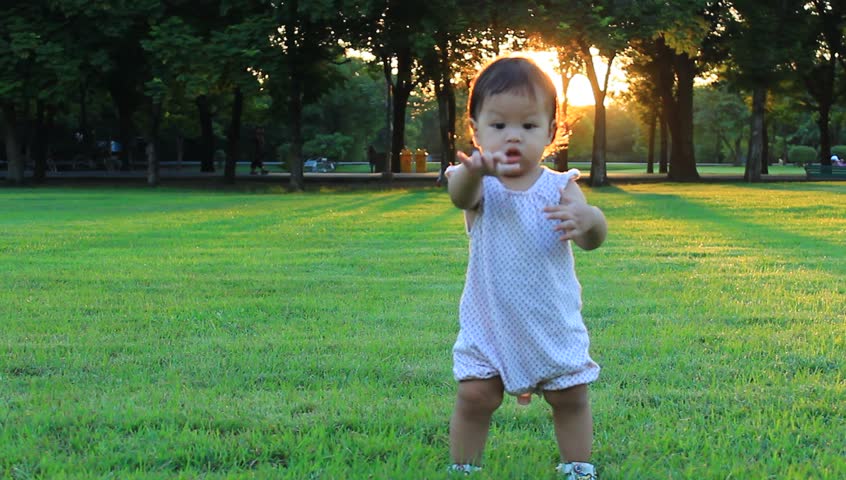
At what age do babies walk?
Most babies take their first steps sometime between 9 and 12 months and are walking well by the time they're 14 or 15 months old. Don't worry if your child takes a little longer, though! Some perfectly normal children don't walk until they're 16 or 17 months old. During her first year, your baby is busy developing coordination and muscle strength in every part of her body. She'll learn to sit, roll over, and crawl before moving on to pulling up and standing at about 9 months.
From then on, it's a matter of gaining confidence and balance. One day your child's standing against the couch – maybe sliding along it – and the next she's tottering hesitantly into your waiting arms. Then she's off and running, leaving babyhood behind. Your child's first steps are her first major move toward independence.
How babies learn to walk
Your newborn's legs aren't nearly strong enough to support him yet, but if you hold him upright under his arms, he'll dangle his legs down and push against a hard surface with his feet, almost as if he's walking. This is a reflexive action, and he'll only do it for a couple of months.
By the time your baby's about 6 months old, he'll bounce up and down if you let him balance his feet on your thighs. Bouncing will be a favourite activity over the next couple of months, as your baby's leg muscles continue to develop while he masters rolling over, sitting, and crawling.
At about 9 months, your baby will probably start trying to pull himself up to a stand while holding onto furniture (so make sure everything in his path is sturdy enough to support him). If you help him along by propping him up next to the sofa, he'll hang on tight.
At 9 or 10 months, your baby will begin to figure out how to bend his knees and how to sit after standing – which is harder than you might think!
After mastering the standing position, at about 12 months, he'll start to cruise, moving from one piece of furniture to the next for support. He may even be able to let go and stand without support.
About this time, your baby will also probably be stooping and squatting. Once he can do that, he may be able to scoop up a toy from a standing position or take steps when held in a walking position. He may even walk while gripping your hand, though he probably won't take his first steps alone for at least a few more weeks. Most children make those early strides on tiptoe with their feet turned outward.
At 12 months, many toddlers are walking on their own – albeit unsteadily. If yours still hasn't stopped cruising, it just means walking on his own is going to take a little longer.
How to help your baby walk
As your baby learns to pull himself up to a standing position, he may need some help figuring out how to get back down again. If he gets stuck and cries for you, don't just pick him up and plop him down. Show him how to bend his knees so he can sit down without toppling over and let him give it a try himself.
You can encourage your baby to walk by standing or kneeling in front of him and holding out your hands. Or you might hold both his hands and let him walk toward you. He'll probably also enjoy a toddle truck or push toy that he can hold on to as he walks. (Look for toddle toys that are stable and have a wide base of support.)
Always make sure your baby has a soft, safe environment in which to hone his new skills. Follow standard childproofing guidelines, and never leave your baby unattended.
What to do if baby doesn’t walk?
Don't fret if your child is simply taking her time. But if your child doesn't stand with support at 12 months, can't walk at 18 months, or isn't able to walk steadily at the age of 2 years, bring it up with her doctor during her milestone check-ups.
Keep in mind that babies have different timetables, and premature babies may reach this and other milestones later than their peers. If your baby was premature, you should date her milestones from your due date, which pediatricians refer to as your baby's adjusted age.
Article was adapted from Baby Center
Pregnancy and Baby Singapore provides you with the latest news and practical tips to help you in your parenting journey. For more tips on your pregnancy and baby in Singapore, subscribe to our mailing list and like us on Facebook, to receive new articles for mummies like you every week!
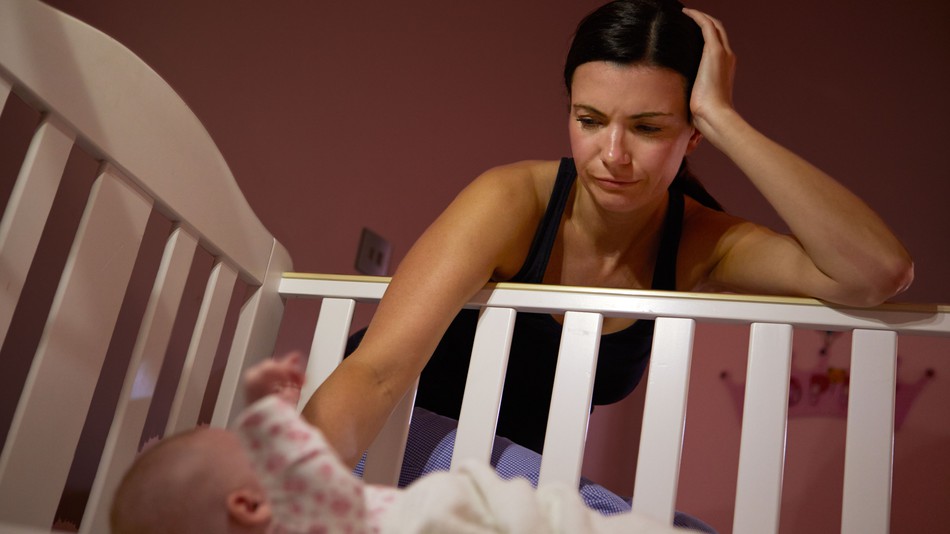
The Fading method falls between the spectrum of the cry it out (CIO) and no tears methods – it’s a middle-ground for parents who believe that CIO is too harsh, and no tears is too gentle and time consuming.
This method works for babies who are at least 5 months old, and can be adapted for toddlers and pre-schoolers. As with all sleep training methods, the goal is to get more rest for everyone involved!
If you've missed our article on Sleep Training Basis, read it here!
How does the fading method work?
It’s similar to the CIO method and can be seen as a much more gentle version of it. There are two main approaches to fading – camping out and timed check-ins. The both require you to put baby to bed while they drowsy but awake, and then reassuring them with your presence.
For camping out, you simply need to sit in a chair next to baby’s crib until they’re asleep – if they cry or fuss, you soothe them without picking them up. Picking them up might work to soothe them faster, but if they fall asleep in your arms, it defeats the purpose of sleep training as they’ll need to learn how to self-soothe.
Every few nights, move the chair further away but still within sight of baby, and within two or three weeks, you should be able to just leave the room after saying good night to them.
For timed check-ins, it’s just as the name says – after you’ve put baby to bed, leave them alone for short intervals of around 5 minutes, then return to reassure them if they start fussing or crying. Repeat this until baby is asleep, and it should be a lot easier after a few weeks of doing so.
You might notice some similarities between timed check-ins and the Ferber method, but the Ferber method requires you to do progressively longer check-in timings as the nights pass, whereas time check-in is a standard waiting time every night.
Why use the fading method?
Similar to the Ferber method in the belief that self-soothing is an important skill that baby needs to pick up in order to become independent. Rocking or nursing baby to sleep is an amazing feeling, but there’s a chance that they’ll rely on you to comfort them back to sleep every time they wake up during the night.
As mentioned before, the fading method helps us parents to find the right balance between helping baby too much and too little.
Does the fading method work?
The important thing to take note of is that no single sleep training method will work with every baby due to their differing personalities, so it’s important to experiment with different sleep training methods to find one that works for your family.
For parents who see improvement in baby’s sleep, it usually occurs within two weeks.
Pregnancy and Baby Singapore provides you with the latest news and practical tips to help you in your parenting journey. For more tips on your pregnancy and baby in Singapore, subscribe to our mailing list and like us on Facebook, to receive new articles for mummies like you every week!
Copyrighted Pregnancy & Baby by Mummys Market 2019
